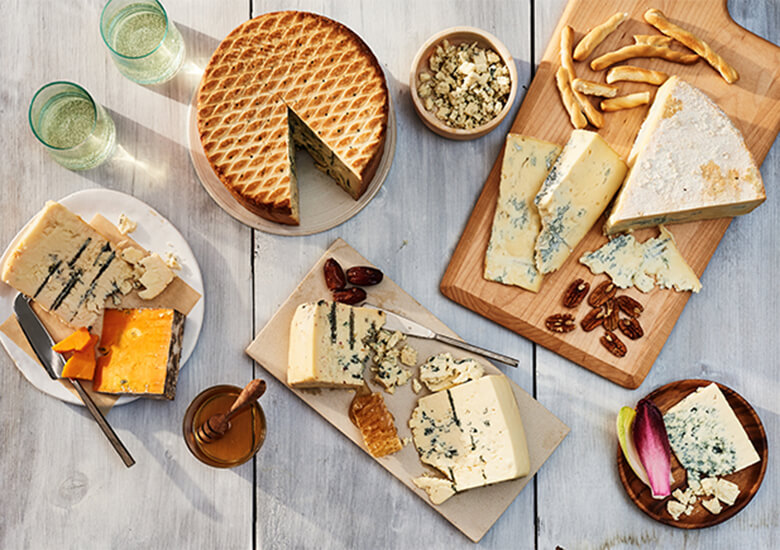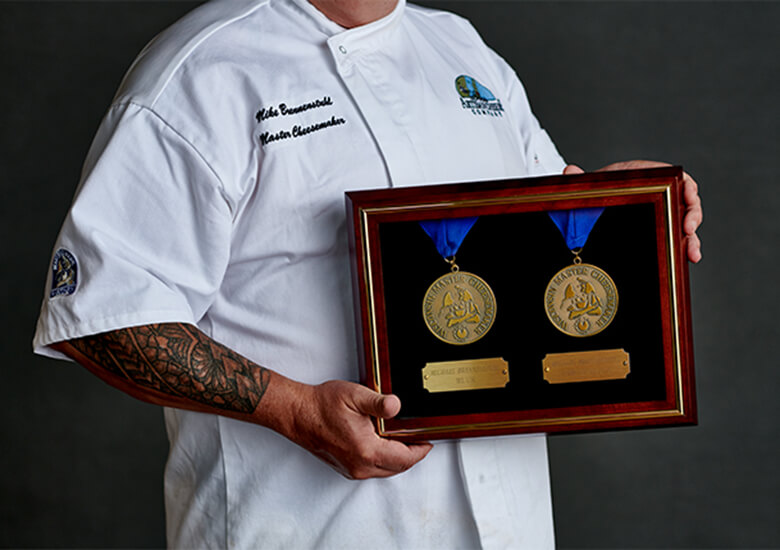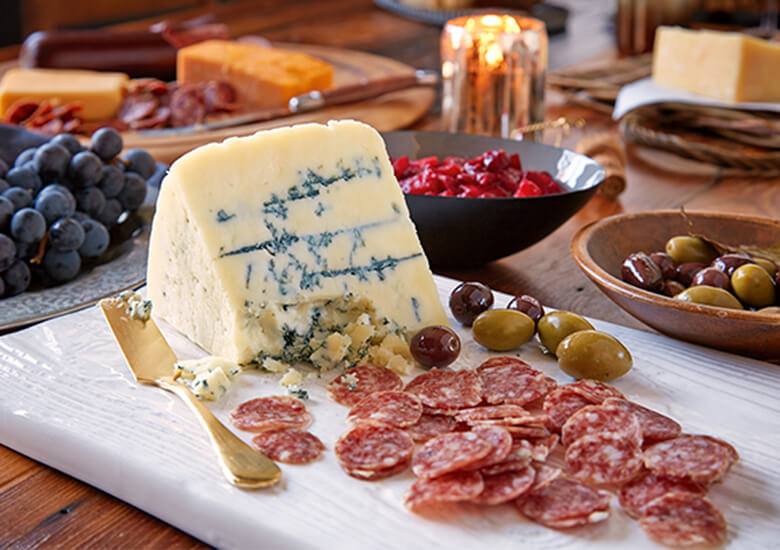It’s not just a fun name to say, it’s a treat to eat. Say hello to gorgonzola: the crowd-pleasing, cow’s milk blue cheese that’s earned a spot on any well-rounded cheeseboard.
From its iconic blue-green veining and unforgettable aroma to its crumbly, melt-in-the-mouth texture, this complex and flavorful cheese deserves every bit of your attention. If you’ve ever wanted to know more about gorgonzola, you’ve come to the right place.
Cheese History: The story behind gorgonzola

Gorgonzola was born in Italy, in a town called…Cheddar. Just kidding! This great cheese was born in the Lombardy region in the north of Italy. Legend has it that a young cheesemaker was distracted by his lover, and accidentally left his cheese curds draining overnight creating a nice home for some lucky mold spores.
Hoping to hide his mistake, the lovestruck cheesemaker mixed the new curds in with the old and pressed them together for aging. A few weeks later, he found blue marks, and upon tasting the results, realized that he’d made a promising discovery. The old and new curds don't perfectly meld in the vat, which leaves lots of nooks and crannies for Penicillium glaucum (gorgonzola's defining mold) to grow giving the cheese its distinct look and taste. Originally named Stracchino or Stracchino di Gorgonzola, the town where the bulk of its trading took place but not where it was made, it remains a favorite today.
Whether the legend holds true or not, we curd-n’t be happier that cheesemakers brought gorgonzola to life. When immigrants from Italy moved to Wisconsin, they brought their cheesemaking chops and love of these stinky cheeses with them—inspiring generations of blue-ievers to come.
All about gorgonzola cheese

What does gorgonzola cheese taste like?
Gorgonzola tastes like a rustic barnyard nestled in a field of lush, green grass. While that might sound crazy, you’ll know what we mean once you try it. This blue cheese is full-flavored, salty, and earthy.
Depending on how long it’s aged, the texture can range from creamy and soft to semi-firm and crumbly. If you ask us (and you should), all varieties are delicious.
How is gorgonzola cheese made?
Gorgonzola starts off like most cheeses–rennet is added to milk, which reacts and creates curds and whey. However, to make gorgonzola one extra-special ingredient is added: the aforementioned Penicillium glaucum.
Don’t worry, this mold is the good kind, and it’s what creates gorgonzola’s unmistakable flavor. Once the whey is drained and the curds pressed, the cheeses are tucked away to mature.
During the aging process, cheesemakers regularly pierce the cheese with metal rods to create air channels in the cheese that enable the mold to grow. This creates the distinctive veining that makes gorgonzola so eye-catching. While gorgonzola is usually aged for three to four months, it can be left even longer depending on the desired texture and flavor.
What’s the difference between gorgonzola and blue cheese?
Gorgonzola and blue are like squares and rectangles…well, that analogy might only make sense if you paid attention during geometry instead of daydreaming about cheese. (Which we definitely, definitely didn’t do.) Basically, all gorgonzola cheeses are blue, but not all blue cheeses are gorgonzola.
Blue cheese is a general category of cheese that can be made with different kinds of milk (like cow, goat and sheep) while gorgonzola is a specific variety within that category made with cow’s milk. While no two blue cheeses are the same, gorgonzola is typically softer and milder than other blue cheeses.
Why does gorgonzola smell?
Gorgonzola’s signature funky smell comes from the mold Penicillium glaucum that is added during the cheesemaking process. While we consider the aroma to be part of the whole delicious experience, adding a little drizzle of honey or jam can help mellow the smell while also enhancing the flavor. (Honey is one of our favorite flavor bridges for blue cheese.)
If you’re looking to learn more about the molds used in the cheesemaking process, we’ve got the basics covered right here.
How long is gorgonzola cheese aged?
Gorgonzola is typically aged for three to four months. Younger varieties, aged for a minimum of two months, are creamier and milder, while aged gorgonzola becomes sharper, saltier, and firmer as the cheese loses moisture. We recommend trying both a young and aged gorgonzola so you can compare—the difference in taste and texture will blue you away!
Must-try Wisconsin gorgonzola cheeses

BelGioioso Gorgonzola: This gorgonzola from BelGioioso Cheese is a stellar example of the classic. Aged for 90 days, this cheese is crumbly, piquant, and earthy. We love this sprinkled over salads or sliced on a sandwich.
Sartori Dolcina Gorgonzola: Dolce means sweet, and we’d have to agree—this cheese is a sweet addition to any cheeseboard. Sartori Cheese's award-winning gorgonzola is aged a bit longer, around four months, creating a complex sharpness that is both intriguing and challenging. Unique to this cheese is the cream that’s added during production, which creates a super-smooth texture and unctuous richness.
Carr Valley Cheese’s Glacier Gorgonzola: Described as a “symphony of pure flavor,” this soft blue cheese is a great option for umami lovers. Carr Valley adds mushroom truffle to create a delicate earthiness that’s as tasty on its own as it is melted over pasta.
Hook’s Gorgonzola: Hook’s signature gorgonzola is well-decorated, having won 2nd place in the 2013 World Cheese Championship and 3rd Place at the 2010 American Cheese Society Competition. Made for the more adventurous cheese lover, this tangy cheese is aged for about a year to give it a punchy flavor and acidic aftertaste.
Pairing gorgonzola cheese

What beer goes well with gorgonzola cheese?
We always suggest matching the intensity of the cheese with the intensity of the drink, so that one doesn’t overpower the other. With a stronger-flavored cheese like gorgonzola, we suggest pairing a rich stout or porter which can stand up to the cheese’s complexity.
What wine pairs best with gorgonzola cheese?
We suggest pairing gorgonzola with a rich, full-bodied red wine like a malbec, zinfandel, or even a port. For our white wine fans, you can’t go wrong with a crisp riesling.
What accompaniments should I serve with gorgonzola cheese?
Blue cheese, particularly gorgonzola, pairs well with honey and sweet jams. Pears and tart green apples, like a Granny Smith, add brightness and a little palate cleanse in between bites. For crunch, try walnuts, pecans, or Marcona almonds.
If you’re ready to take a deeper look into the world of cheese pairing, we recommend starting with our beginner’s guide to cheese pairing.
Ready, set, sample!
Ready to gorge on gorgonzola? Impress your friends and family with a cheese tasting right at home. Get Wisconsin’s finest cheeses and cheese gift baskets delivered right to your door with our continuously updated list of cheesemakers and retailers that allow you to order cheese online. Award-winning Wisconsin Cheese is just a click away.
Craving something else? Choose from our selection of over 400 recipes featuring Wisconsin Cheese. Don’t forget to share your creative cheesy creations with us on Facebook and Instagram!
